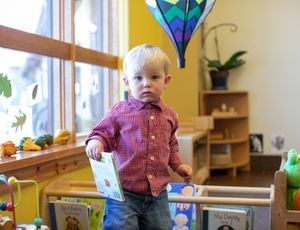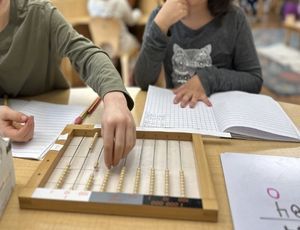From the time your baby was born, there have been many milestones he has conquered, and many opportunities for healthy separations between you and he have come along. First, the physical detachment of coming out of your body, then starting a solid diet that is no longer given by your body, and finally, crawling, where your child can explore as he pleases and come back to you as needed. However, there is another milestone that he will conquer, and it will happen naturally during the next couple of months: walking. In this month’s article, we will discuss how infants start walking, how we can support them, and how we can prepare ourselves for their new independence.
From the time your baby was born, there have been many milestones he has conquered, and many opportunities for healthy separations between you and he have come along. First, the physical detachment of coming out of your body, then starting a solid diet that is no longer given by your body, and finally, crawling, where your child can explore as he pleases and come back to you as needed. However, there is another milestone that he will conquer, and it will happen naturally during the next couple of months: walking. In this month’s article, we will discuss how infants start walking, how we can support them, and how we can prepare ourselves for their new independence.
Look Mom, No Hands!
Children will develop gross motor skills if we let them unfold naturally, but it can be tempting to try to teach them how to do it without allowing them to do it by themselves. Many times, when we observe that children start to pull up from furniture, our reaction might be to hold their hands and make them walk forward. These actions usually come with very good intentions, but are they really beneficial for their gross motor development? How can we help them without interfering with their own timetables and motivations? Here are a few things to consider to better support children to walk independently at their own pace.
Prepare the space
Before children have control of their balance and enough strength in their muscles to walk without any support, they do move, cruising and holding onto anything they can find in the room. Prepare the space for him with low furniture. It does not need to be a fancy cabinet from a Montessori retailer. It can be anything safe for your child, such as an ottoman, coffee table, low stool, etc. The more opportunities your child has to move around naturally supporting his body, the sooner he will experiment, giving one or two steps without any support.
Provide proper clothing
Nowadays, there are many clothing options for infants; some are made with fashion in mind like tight jeans with bulky belts, jackets with multiple zippers and long sleeves, etc. What we need to have in mind is the freedom of movement and the comfortable movement of your child’s body. That is a crucial aspect of gross motor skills, as is the freedom of bending knees, elbows, cruising, etc. Make sure your child wears comfortable clothing that is the correct size so he can move freely in the space you prepared for him. Avoid pants or dresses that are too long and can cause the child to step on and fall.
Be outdoors as well
Use the space outdoors too. There are many opportunities at parks for children to practice climbing and pulling up, and that motivates them to walk as well. Allow freedom of movement in this setting and enjoy some time outside with your child.
Remove any obstacles
So far, your child has been using his entire body to move around by slithering, crawling and holding onto furniture around the room. His hands have been very helpful in moving from one point to another. However, when he starts walking, his hands will be free to explore and master his environment in a new way. As this milestone comes closer, you have to remove any dangers such as glass, wires, tablecloths that he might pull, or any item that could harm your child and give him negative feedback on walking. The environment should be prepared in such a way that the adult can provide the child with the freedom to practice.
Also remember sometimes we are the obstacle. Observe yourself when your child is freely moving. Are you directing? Are you interfering with his concentration? If this is the case, step back and watch your child’s development unfold in front of your eyes. Remember, children know what they should be doing next, so trust the timetable your child has.
Avoid praising and showing him off
When we see our child take their first steps, it is an exciting moment that we want to share with everybody. While that is understandable, your baby is no longer a baby but a young toddler. So why should we not ask a child to show everybody how beautifully he walks now? Well, any gross motor skill takes time to be mastered; it needs a lot of practice, and it needs to be when the child wants to practice. When we ask our child to show aunt Susan how he walks, we are putting him on the spot. If he falls, he will know he did not show off his new skills properly and will get negative feedback; he might even feel he is not enough. Children are excellent at reading facial expressions and any body language the adult uses. If we celebrate and clap at him when he gives three steps, but we do not do it when he gives just one step, then he will be affected by that. Remember, children are motivated from the inside; there is no need for extrinsic motivation. Respect their time and enjoy them.
Item of the Month
Baby Walker Radio Flyer
This is a wagon for the child to push and practice walking. This particular brand is heavy, so the child has a better balance and does not tip as he pulls up on it.
Link to buy it at Amazon.com: https://www.amazon.com/-/es/Vag%C3%B3n-cl%C3%A1sico-pasear-Radio-Flyer/dp/B00KN0LSUI/ref=sr_1_3?__mk_es_US=%C3%85M%C3%85%C5%BD%C3%95%C3%91&keywords=radio+flyer+walker+babya&qid=1582224167&sr=8-3
Have a little extra time?
Take a look at this movement chart Dr. Maria Montessori created for the child under three years old. It is part of Chapter 3 of her book, The Absorbent Mind. It illustrates the development of equilibrium and the hand. Keep in mind that every child has its own pace and might not conquer each skill precisely at the same time it is marked on the timeline. The big take away from it is that every skill takes months; it is a complex process where the brain and the body are connected. Even if we want to see our children conquer all of these skills as soon as possible, the reality is that it depends on the child’s body and on our ability to prepare the space and ourselves to support it.



